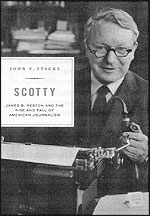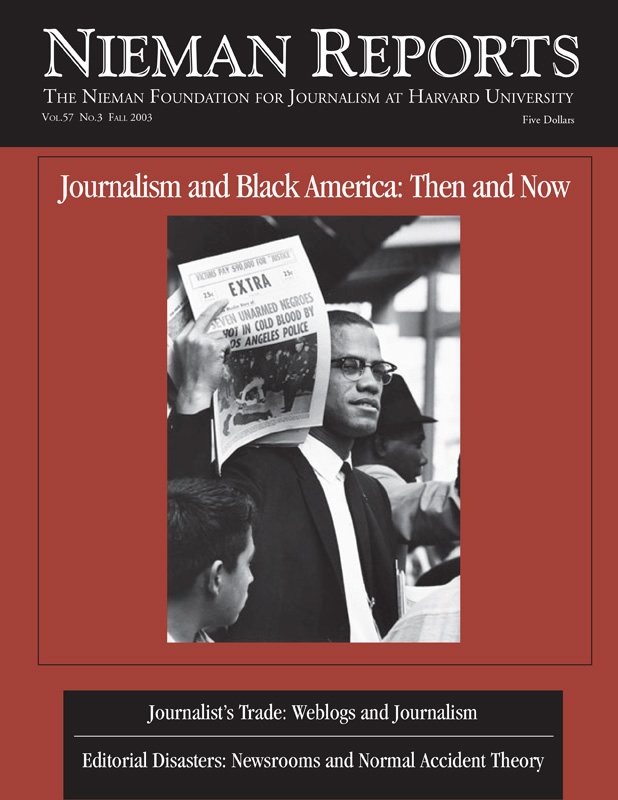
Scotty: James B. Reston and the Rise and Fall of American Journalism
John F. Stacks
Little, Brown and Company. 373 Pages. $29.95.
One particular moment in John F. Stacks’s biography of Scotty Reston vividly demonstrates the distance American journalism has traveled since Scotty’s heyday in the 1950’s and 1960’s. The book’s title is “Scotty: James B. Reston and the Rise and Fall of American Journalism,” and its essential argument is that we would all be far better off if the news—particularly political news—was covered the way Scotty did it when he was running the Washington bureau of The New York Times.
It is an argument that has some merit. But then one comes to the moment on page 227 in which Stacks describes the immediate aftermath of John F. Kennedy’s assassination. Eileen Shanahan, one of Scotty’s stalwarts in the bureau, recounts how late in the evening of the assassination, Scotty assembled the bureau to talk about what to do next. Lyndon B. Johnson was now President, and the bureau discussed his limitations on foreign policy and the likelihood that he would make mistakes. Shanahan recalled that almost every dip and turn of LBJ’s roller coaster of an administration was foretold that night, which testifies to the shrewdness and acumen of the journalists present. But at one point, Scotty said to the group, “I am not encouraging enterprise on the Bobby Baker story.” The bureau had been in pursuit of the corruption story that would eventually send Baker, one of LBJ’s close friends, to jail. “We all knew what he meant,” Shanahan told Stacks. “He didn’t have to say the country is in a state of trauma. It would not be the patriotic thing to undermine this new President who is coming into office in these horrible circumstances.”
It is difficult to imagine such a journalistic protective mantle being cast over any President since LBJ, especially by The New York Times. The gentle handling of George W. Bush by many in the media seems to be prompted more by fear of being labeled unpatriotic than from Scotty’s Olympian judgment that truth should sometimes come second to mercy.
Reston’s Moral Journalism
Stacks’s interesting and provocative book presents Reston as unquestionably Olympian, but with the strong patriotism of a grateful Scottish immigrant and the moral code of a strict Calvinist. The same Scotty Reston who declined to pursue Bobby Baker had a month earlier fiercely resisted JFK’s push to have David Halberstam removed from Vietnam because of his “pessimistic” coverage. It is the same Scotty Reston who a few years later thundered that if the Times would not publish the Pentagon Papers, which was then in doubt, he would do so as owner of The Vineyard Gazette, his weekly newspaper in Martha’s Vineyard.
And it is the same Scotty Reston who, at the end of his life, defended his judgment that the Times should not have published the article announcing that there was soon to be an invasion of the Bay of Pigs. As it was, the article was greatly softened at Scotty’s urging and the role of the CIA removed, but Scotty’s view was that nothing should have been published at all.
Reston emblemized a moral journalism that could be tough or gentle depending on the situation, and he and his peers felt comfortable making those choices based on their sense of what was best for the nation. Political figures had no choice but to treat the most powerful newspaper columnists and journalists with respectful attention, not to say fawning solicitousness. And in return, they were treated with a kind of journalistic noblesse oblige that kept personal failings and the sausage-making aspects of government out of the paper.
His style of journalism was succeeded by the adversarial, aggressive and intrusive reporting that has dominated the American press—at least until September 11. It is ironic that Reston was a key instrument in advancing that evolution, a change that he largely despised. Journalistically, he was a product of World War II, when there was a clear good side and a clear bad side, and the U.S. government was unquestionably with the angels. His style of political reporting never lost that faith.
The turning point in his career came when he caught the attention—and affection—of Arthur Hays Sulzberger, the Times’s publisher in the 1940’s and ’50’s, and his wife, Iphigene, the daughter of Adolph Ochs. To the Sulzbergers, Scotty embodied the best in journalism and in American character, and his talent and resourcefulness made him the paper’s star. Though Scotty was not an intellectual and had graduated from a non-Ivy League university, his ambition was to attract the best and the brightest to journalism. He wanted college graduates, and especially graduates from the elite schools, to enter journalistic ranks. Until the 1950’s, reporting was generally viewed as a blue-collar job, even at the elite papers.
He encouraged a new generation of highly educated reporters to enter the ranks of newspapers. Many of them cut their teeth covering the civil rights movement, which was another good vs. bad story, but with a twist. This time, the bad guys were often police and public officials, and these new reporters had the confidence to challenge authority. The next big story for many was Vietnam, where they arrived with an attitude that was distant from the in-it-together era of Scotty Reston. Halberstam, for instance, infuriated President Kennedy with his reporting that challenged the official version of events. And Halberstam and many in his generation of reporters were Scotty’s boys, either literally or by inspiration. Scotty himself was less critical of the war. Indeed, his fury over the Pentagon Papers’ revelations of systematic governmental lying was probably prompted in part by having believed many of those lies.
The best of Scotty Reston was that he loved both journalism and his country, and he had a solidly anchored gyroscope that told him when one took precedence over the other. His was not a compass that was influenced by fear, but by compassion and maturity.
The fall of journalism since Scotty’s day is not that too many negative and invasive stories are published. It is that so many of them seem to be published without a sense that an honest and responsible person in authority thought the matter through and then did what had to be done. What has been lost is a sense that there is a Scotty calling the shots. But it is important to remember that if Scotty were calling the shots, there are things that we know about politics and politicians that readers would likely not be told. Knowing less, while sometimes a blessing, is a painful bargain to strike.
Alex S. Jones, a 1982 Nieman Fellow, is director of the Joan Shorenstein Center on the Press, Politics, and Public Policy. He coauthored “The Trust: The Private and Powerful Family Behind The New York Times.”



